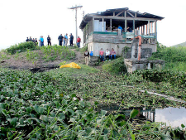
Honduran society remains shocked at the tragic fate of Aníbal Barrow, a journalist and university professor whose body was dismembered and scattered around a lake in Villanueva, in the northern province of Cortés. Stunned, in broken voices, the reporters who covered the recovery of Barrow’s remains told how his clothes and personal documents were found buried, and later on, parts of his body were discovered wrapped in bags while other parts were found in a different spot, charred from burning.
![]() (IPS) – Honduran society remains shocked at the tragic fate of Aníbal Barrow, a journalist and university professor whose body was dismembered and scattered around a lake in Villanueva, in the northern province of Cortés.
(IPS) – Honduran society remains shocked at the tragic fate of Aníbal Barrow, a journalist and university professor whose body was dismembered and scattered around a lake in Villanueva, in the northern province of Cortés.
Barrow, 65, was kidnapped on Jun. 24 in the city of San Pedro Sula, the provincial capital, 450 km north of Tegucigalpa, as he was riding in his car with family members and a driver, who were released unharmed by the unidentified gunmen
The car was found several hours later, with a bullet hole in one of the doors, and traces of blood inside. Barrow’s remains were discovered 15 days later in a swamp next to a lagoon near the community of Siboney, in Villanueva.
Social analysts say the murder indicates that Honduras has entered a phase of “high-profile violence,” and that reporters are the favorite victims in order to spread terror. In the past three and a half years, 29 media workers have been killed on the job.
“We are experiencing a kind of violence that was not seen 15 years ago. The way criminals are operating has changed. This action is more like a message from organized crime in the 21st century – a long way from the banditry seen in Honduras in the 19th century,” historian and social analyst Rolando Sierra told IPS.
“This is high-profile violence. The victims are not ordinary citizens, but well-known journalists, evangelical preachers, lawyers or human rights activists; in other words, the violence is spreading towards sectors that have a greater impact on society,” he said.
Stunned, in broken voices, the reporters who covered the recovery of Barrow’s remains told how his clothes and personal documents were found buried, and later on, parts of his body were discovered wrapped in bags while other parts were found in a different spot, charred from burning.
“It was a cruel and abominable deed,” said Human Rights Commissioner Ramón Custodio.
Journalist Jorge Oseguera, a friend of Barrow’s and a correspondent for the HRN radio station in Tegucigalpa, said he found the “macabre act” unbelievable.
Choking on his words, Oseguera said, “we who work in the media have become used to violence, but when it affects someone close to us, a colleague and friend, all we can say is that these killing machines have no mercy for anyone.”
The murdered journalist was host of a popular morning talk show on the Globo TV channel in San Pedro Sula, where he also taught mathematics at the National Autonomous University of Honduras.
Four suspects have been arrested, but 10 people have been implicated by a protected witness who was one of the hired killers, said the head prosecutor at the Public Prosecutor’s Office, Roberto Ramírez. The motive for the murder has not been revealed.
Honduras has an average of 20 murders a day and its annual homicide rate in 2012 was 85.5 per 100,000 population, nearly 10 times the global median rate of 8.8 per 100,000. It is considered one of the most violent countries in the world.
The security ministry has announced it aims to reduce the homicide rate to 80 per 100,000 population this year. However, the authorities have not spoken to the press for two months, limiting their information to official communiqués that do not give murder figures.
The National Human Rights Commission has recorded 36 journalists murdered since 2002. But 29 of the killings have taken place since right-wing President Porfirio Lobo took office in January 2010.
Impunity is the common factor in these cases, only one of which has led to a firm sentence. Prosecutor Ramírez, however, is hopeful that Barrow’s grisly murder will be solved soon, due to the abundance of evidence.
Honduras is regarded as an especially high-risk country for journalists. Killings of reporters are concentrated in 10 of the 18 provinces, most of them known for drug trafficking problems.
In the view of journalist and university professor Miguel Martínez, “the viciousness of Barrow’s murder takes us back to the 1990s in Colombia, or to Mexico today. And it indicates the need for a debate on organized crime and extradition.”
“There is plenty to discuss. It would seem that this (murder) was a message sent by organized crime, because of its characteristics, but the time has come for the press to know how to behave in the face of the coming avalanche, and what safety protocols should be used,” Martínez said.
Bertha Oliva, a prominent Honduran human rights activist, told IPS the murder showed “disrespect for life, for freedom of expression, and for those who are the link between society and the state. We have to get to the bottom of this and find out why he was killed.”
